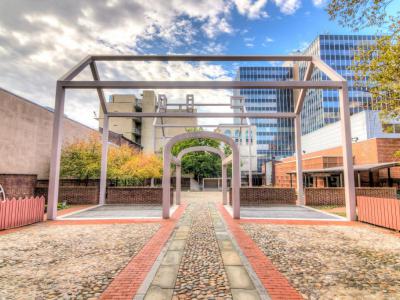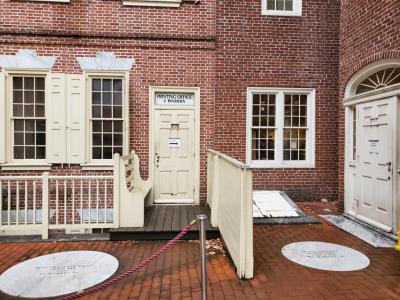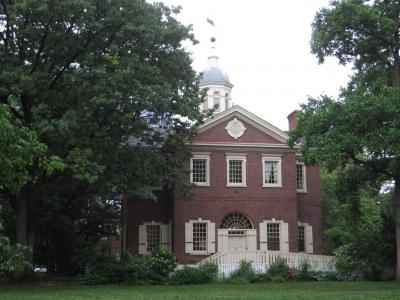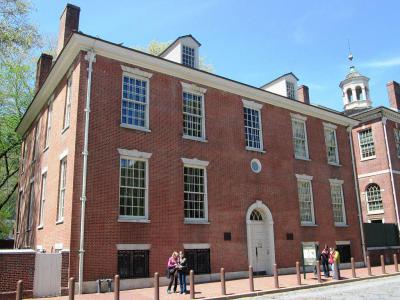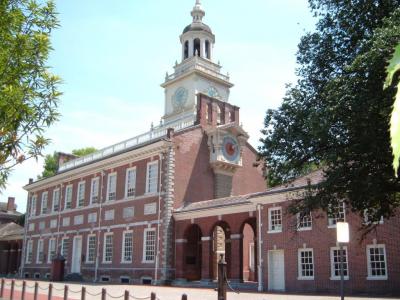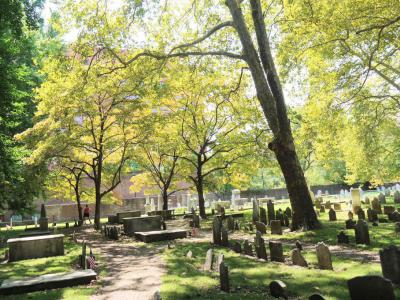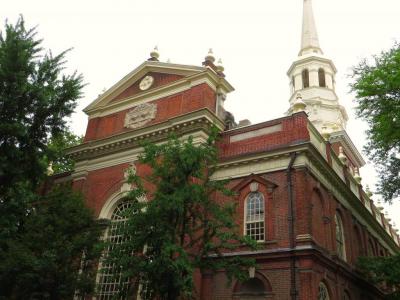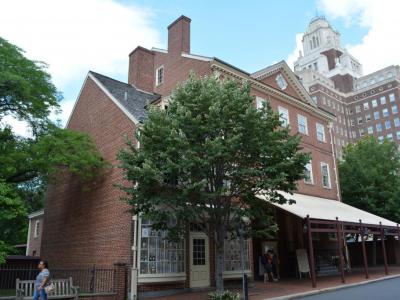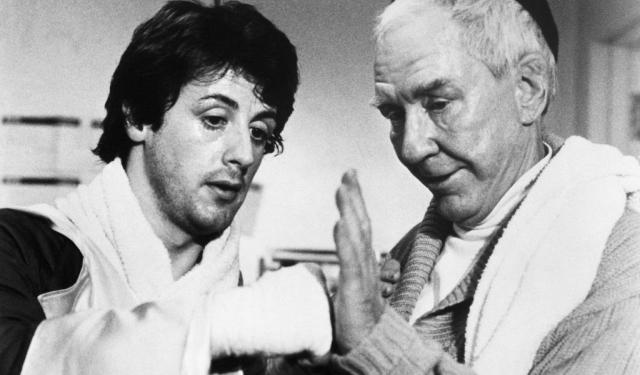Benjamin Franklin's Philadelphia (Self Guided), Philadelphia
Benjamin Franklin's journey to becoming one of the most influential figures in Revolutionary America began when he, as a teenager, ventured from a Puritan family in Boston to Philadelphia. This city would not only become his home but also a stage for his remarkable life as a writer, printer, philosopher, postmaster, scientist, inventor, statesman, and diplomat. His life epitomizes the American Dream.
Among the key locations that encapsulate Franklin's legacy is the Benjamin Franklin Museum and Court. The museum offers a deep dive into Franklin’s life, showcasing his inventions, writings, and experiments. In the courtyard, one can see the remanent of his former residence.
Just a short walk away, visitors can also explore the Franklin Court Printing Office, where Franklin’s legacy as a printer and publisher is preserved in a working print shop setting.
Not far from these sites is Carpenters' Hall, renowned for hosting the First Continental Congress, where Franklin and others convened in secret to discuss French support for the American Revolution. Close by, Philosophical Hall stands as another testament to Franklin’s intellectual pursuits, housing the American Philosophical Society which he founded.
A few steps away, Independence Hall resonates with the echoes of the debates and decisions where Franklin played pivotal roles, notably during the signing of both the Declaration of Independence and the Constitution.
A short distance from these halls of power and thought, the Christ Church Burial Ground is where Franklin’s mortal journey concluded. His grave remains a place of pilgrimage for those who wish to honor his monumental impact. Nearby, the original Christ Church continues to tower, where Franklin and other historical figures once gathered under its esteemed steeple.
Fireman's Hall, another Franklin-initiated institution, highlights his commitment to improving fire safety, a significant concern during his time. The museum not only celebrates Franklin's pioneering contributions to firefighting but also chronicles the evolution of fire service in Philadelphia.
Lastly, the historic City Tavern, where Franklin and contemporaries frequently engaged in spirited discussions over hearty meals, offers a taste of the colonial era, allowing visitors to relive the ambiance and camaraderie of revolutionary Philadelphia.
These landmarks collectively trace Benjamin Franklin’s profound influence on the city and nation, inviting all to walk in the footsteps of one of America's most venerated Founding Fathers. For those eager to experience these historical treasures, a self-guided tour through the City of Brotherly Love awaits.
Among the key locations that encapsulate Franklin's legacy is the Benjamin Franklin Museum and Court. The museum offers a deep dive into Franklin’s life, showcasing his inventions, writings, and experiments. In the courtyard, one can see the remanent of his former residence.
Just a short walk away, visitors can also explore the Franklin Court Printing Office, where Franklin’s legacy as a printer and publisher is preserved in a working print shop setting.
Not far from these sites is Carpenters' Hall, renowned for hosting the First Continental Congress, where Franklin and others convened in secret to discuss French support for the American Revolution. Close by, Philosophical Hall stands as another testament to Franklin’s intellectual pursuits, housing the American Philosophical Society which he founded.
A few steps away, Independence Hall resonates with the echoes of the debates and decisions where Franklin played pivotal roles, notably during the signing of both the Declaration of Independence and the Constitution.
A short distance from these halls of power and thought, the Christ Church Burial Ground is where Franklin’s mortal journey concluded. His grave remains a place of pilgrimage for those who wish to honor his monumental impact. Nearby, the original Christ Church continues to tower, where Franklin and other historical figures once gathered under its esteemed steeple.
Fireman's Hall, another Franklin-initiated institution, highlights his commitment to improving fire safety, a significant concern during his time. The museum not only celebrates Franklin's pioneering contributions to firefighting but also chronicles the evolution of fire service in Philadelphia.
Lastly, the historic City Tavern, where Franklin and contemporaries frequently engaged in spirited discussions over hearty meals, offers a taste of the colonial era, allowing visitors to relive the ambiance and camaraderie of revolutionary Philadelphia.
These landmarks collectively trace Benjamin Franklin’s profound influence on the city and nation, inviting all to walk in the footsteps of one of America's most venerated Founding Fathers. For those eager to experience these historical treasures, a self-guided tour through the City of Brotherly Love awaits.
How it works: Download the app "GPSmyCity: Walks in 1K+ Cities" from Apple App Store or Google Play Store to your mobile phone or tablet. The app turns your mobile device into a personal tour guide and its built-in GPS navigation functions guide you from one tour stop to next. The app works offline, so no data plan is needed when traveling abroad.
Benjamin Franklin's Philadelphia Map
Guide Name: Benjamin Franklin's Philadelphia
Guide Location: USA » Philadelphia (See other walking tours in Philadelphia)
Guide Type: Self-guided Walking Tour (Sightseeing)
# of Attractions: 9
Tour Duration: 2 Hour(s)
Travel Distance: 2.5 Km or 1.6 Miles
Author: leticia
Sight(s) Featured in This Guide:
Guide Location: USA » Philadelphia (See other walking tours in Philadelphia)
Guide Type: Self-guided Walking Tour (Sightseeing)
# of Attractions: 9
Tour Duration: 2 Hour(s)
Travel Distance: 2.5 Km or 1.6 Miles
Author: leticia
Sight(s) Featured in This Guide:
- Benjamin Franklin Museum and Court
- Franklin Court Printing Office
- Carpenters' Hall
- Philosophical Hall
- Independence Hall
- Christ Church Burial Ground
- Fireman's Hall
- Christ Church
- City Tavern
1) Benjamin Franklin Museum and Court
The Benjamin Franklin Museum lies in the fully-enclosed courtyard where the Founding Father's house and print shop once stood. Although these were torn down long ago, some archaeological remains were excavated and are visible beneath glass windows in the ground along with explanatory signs.
"Ghost" houses were built in the exact spots where the house and print shop once stood, so one gets a real sense of how the site would have looked when those structures were standing. There is also a working 18th-century print shop adjacent which is a neat experience.
It doesn't cost anything to walk through Franklin Court, view the "ghost" houses, or visit the working print shop. The museum costs a very reasonable fee. While the space is not huge, it provides a very thorough and interesting overview of Franklin's life and contributions to the country. There are lots of interactive objects for kids and fascinating things to see, read, and ponder for adults.
The visitors can get both an overview of Franklin's life, as well as little interesting tidbits of trivia about him. They even have entertaining videos illustrating some humorous (and informative) episodes in his life, which seem to be everyone's favorite part. All in all, there is something for everyone, regardless of age.
"Ghost" houses were built in the exact spots where the house and print shop once stood, so one gets a real sense of how the site would have looked when those structures were standing. There is also a working 18th-century print shop adjacent which is a neat experience.
It doesn't cost anything to walk through Franklin Court, view the "ghost" houses, or visit the working print shop. The museum costs a very reasonable fee. While the space is not huge, it provides a very thorough and interesting overview of Franklin's life and contributions to the country. There are lots of interactive objects for kids and fascinating things to see, read, and ponder for adults.
The visitors can get both an overview of Franklin's life, as well as little interesting tidbits of trivia about him. They even have entertaining videos illustrating some humorous (and informative) episodes in his life, which seem to be everyone's favorite part. All in all, there is something for everyone, regardless of age.
2) Franklin Court Printing Office
The Franklin Court Printing Office offers an immersive glimpse into the world of 18th-century publishing, showcasing Benjamin Franklin's innovative contributions to the field. Franklin, a pioneer in the publishing business, was the first to incorporate political cartoons and maps alongside his articles, enhancing the visual appeal and accessibility of printed content. He effectively utilized the power of the press to disseminate his political theories, garnering public support and influence.
Among his many publishing ventures, "Poor Richard's Almanac," begun in 1732 under the pseudonym Richard Saunders, stands out for its widespread popularity. The almanac, filled with Franklin's witty and wise sayings, preached frugality, industry, and thrift, becoming a staple in American households until its final publication in 1758.
At the re-created Franklin Court Printing Office, visitors can step back in time to experience the operation of an 18th-century printing office. The facility contains several exhibits, including a typesetting area, a bindery, and two reproduction 18th-century presses. This interactive environment allows visitors to observe firsthand the intricate process of typesetting and printing, with park rangers on hand to demonstrate these traditional techniques.
The Printing Office also houses the newspaper office of Franklin's grandson, Benjamin Franklin Bache, providing insight into the controversial newspaper culture of the 1790s. Bache, like his grandfather, played a significant role in shaping public opinion through his publication. Adjacent to the Printing Office, Benjamin Franklin Bache's house further enriches the historical narrative.
Located in Franklin Court, the Printing Office is easily accessible from Market Street, between 3rd and 4th Streets. Admission is free, and visitors can explore the site on a first-come, first-served basis.
Among his many publishing ventures, "Poor Richard's Almanac," begun in 1732 under the pseudonym Richard Saunders, stands out for its widespread popularity. The almanac, filled with Franklin's witty and wise sayings, preached frugality, industry, and thrift, becoming a staple in American households until its final publication in 1758.
At the re-created Franklin Court Printing Office, visitors can step back in time to experience the operation of an 18th-century printing office. The facility contains several exhibits, including a typesetting area, a bindery, and two reproduction 18th-century presses. This interactive environment allows visitors to observe firsthand the intricate process of typesetting and printing, with park rangers on hand to demonstrate these traditional techniques.
The Printing Office also houses the newspaper office of Franklin's grandson, Benjamin Franklin Bache, providing insight into the controversial newspaper culture of the 1790s. Bache, like his grandfather, played a significant role in shaping public opinion through his publication. Adjacent to the Printing Office, Benjamin Franklin Bache's house further enriches the historical narrative.
Located in Franklin Court, the Printing Office is easily accessible from Market Street, between 3rd and 4th Streets. Admission is free, and visitors can explore the site on a first-come, first-served basis.
3) Carpenters' Hall
Everyone knows about the Second Continental Congress, which signed the Declaration of Independence at Independence Hall. Still, hardly anyone ever talks about the First Continental Congress, which marked a pivotal moment in the lead-up to the American Revolution. It was the first time that the 13 Colonies got together in one spot in defiance of British rule.
Carpenters' Hall was completed in 1773 by the Carpenters' Company of the City and County of Philadelphia, a guild or trade association established in 1724. Architect Robert Smith designed the Hall in the Georgian style, reflecting the architectural preferences of the time.
In 1774, Carpenters' Hall hosted the First Continental Congress from September 5 to October 26. Delegates from 12 of the 13 American colonies (Georgia did not send delegates) gathered to discuss grievances against British policies and to coordinate a united response. Within these walls, key decisions were made, including drafting a unified statement of rights and grievances addressed to King George III.
Notably, Carpenters' Hall was the site of clandestine meetings, such as those between Benjamin Franklin and others, who secretly met with French contacts to discuss French support for the American Revolution.
After the First Continental Congress, Carpenters' Hall was a meeting place for various organizations and events. The Second Continental Congress briefly used it in 1775 before it moved to Independence Hall. The Hall saw multiple uses throughout the 19th and early 20th centuries, including as a bank and a library.
The building was designated a National Historic Landmark on April 15, 1970. Today, Carpenters' Hall is open to the public as a historic site.
Carpenters' Hall was completed in 1773 by the Carpenters' Company of the City and County of Philadelphia, a guild or trade association established in 1724. Architect Robert Smith designed the Hall in the Georgian style, reflecting the architectural preferences of the time.
In 1774, Carpenters' Hall hosted the First Continental Congress from September 5 to October 26. Delegates from 12 of the 13 American colonies (Georgia did not send delegates) gathered to discuss grievances against British policies and to coordinate a united response. Within these walls, key decisions were made, including drafting a unified statement of rights and grievances addressed to King George III.
Notably, Carpenters' Hall was the site of clandestine meetings, such as those between Benjamin Franklin and others, who secretly met with French contacts to discuss French support for the American Revolution.
After the First Continental Congress, Carpenters' Hall was a meeting place for various organizations and events. The Second Continental Congress briefly used it in 1775 before it moved to Independence Hall. The Hall saw multiple uses throughout the 19th and early 20th centuries, including as a bank and a library.
The building was designated a National Historic Landmark on April 15, 1970. Today, Carpenters' Hall is open to the public as a historic site.
4) Philosophical Hall
Philosophical Hall, a historic landmark in Philadelphia, has been the epicenter of intellectual and scientific discourse for over two centuries as the headquarters of the American Philosophical Society (APS). This society, established in 1743, initially lacked a permanent meeting place, leading its members to convene in various locations across Philadelphia. It was not until 1783, forty years after its inception, that the APS members resolved to build a dedicated space for their gatherings.
Their initial consideration was a lot near Arch Street, but fate had a different plan. A lot in the State House yard, now known as Independence Square and adjacent to the renowned Independence Hall, became available. Recognizing the significance of this location, the Pennsylvania Legislative Assembly generously granted this lot to the Society in 1785.
This auspicious beginning marked the start of a challenging journey to erect Philosophical Hall. The Society immediately embarked on the construction, beginning with the excavation of the cellar. However, financial constraints slowed down the progress, stretching the construction period to four years. It was during this time that Benjamin Franklin, a notable member of the Society, stepped in with a crucial loan, providing the final financial push needed to complete the building.
Since its completion, Philosophical Hall has stood as a symbol of the American commitment to intellectual pursuit and scientific inquiry, standing in close proximity to Independence Hall, a site of immense historical significance in the United States. The Hall not only represents the enduring legacy of the APS but also serves as a testament to the collaborative spirit and determination of its founding members, including the likes of Benjamin Franklin.
Their initial consideration was a lot near Arch Street, but fate had a different plan. A lot in the State House yard, now known as Independence Square and adjacent to the renowned Independence Hall, became available. Recognizing the significance of this location, the Pennsylvania Legislative Assembly generously granted this lot to the Society in 1785.
This auspicious beginning marked the start of a challenging journey to erect Philosophical Hall. The Society immediately embarked on the construction, beginning with the excavation of the cellar. However, financial constraints slowed down the progress, stretching the construction period to four years. It was during this time that Benjamin Franklin, a notable member of the Society, stepped in with a crucial loan, providing the final financial push needed to complete the building.
Since its completion, Philosophical Hall has stood as a symbol of the American commitment to intellectual pursuit and scientific inquiry, standing in close proximity to Independence Hall, a site of immense historical significance in the United States. The Hall not only represents the enduring legacy of the APS but also serves as a testament to the collaborative spirit and determination of its founding members, including the likes of Benjamin Franklin.
5) Independence Hall (must see)
By the late 1720s, Philadelphia was in need of a state house. The ground for its construction – on the south side of Chestnut Street, between Fifth and Sixth Streets, to a design by architect Edmund Woolley – was broken in 1732.
Upon its completion in 1753, the Colonial Government of Pennsylvania took occupancy of the State House immediately. The building served as the Capitol of the Province and Commonwealth of Pennsylvania until 1799.
The former Pennsylvania State House, now known as Independence Hall, is a Georgian-style hall with a red brick facade. There is a central building with a bell tower and steeple. The center is attached by arcaded passageways to wings on either side. The steeple spire is 169 feet high. Old City Hall, Congress Hall, and Independence Hall together with Philosophical Hall, share Independence Square.
The Hall underwent several renovations in the 19th and 20th centuries ultimately restoring its 18th-century appearance. On the ground floor are the Assembly Room and the Supreme Court Room, separated by a vestibule. Behind the entrance is the Tower Stair Hall.
On June 14, 1775, the delegates of the Continental Congress chose George Washington to serve as the commander-in-chief of the Continental Army in the Assembly Room of the Independence Hall. Later, on July 26, the Congress named Benjamin Franklin as the first Postmaster General, a position that eventually evolved into the United States Post Office Department.
From 1775 to 1783, the Independence Hall was the main meeting house of the Second Continental Congress. The Declaration of Independence was approved within its walls on July 4, 1776. The United States Constitution was approved here in 1787.
Ever since then, Independence Hall has often served as a venue for speeches, rallies, and protests. Most events have been held on behalf of democratic and civil rights movements.
Upon its completion in 1753, the Colonial Government of Pennsylvania took occupancy of the State House immediately. The building served as the Capitol of the Province and Commonwealth of Pennsylvania until 1799.
The former Pennsylvania State House, now known as Independence Hall, is a Georgian-style hall with a red brick facade. There is a central building with a bell tower and steeple. The center is attached by arcaded passageways to wings on either side. The steeple spire is 169 feet high. Old City Hall, Congress Hall, and Independence Hall together with Philosophical Hall, share Independence Square.
The Hall underwent several renovations in the 19th and 20th centuries ultimately restoring its 18th-century appearance. On the ground floor are the Assembly Room and the Supreme Court Room, separated by a vestibule. Behind the entrance is the Tower Stair Hall.
On June 14, 1775, the delegates of the Continental Congress chose George Washington to serve as the commander-in-chief of the Continental Army in the Assembly Room of the Independence Hall. Later, on July 26, the Congress named Benjamin Franklin as the first Postmaster General, a position that eventually evolved into the United States Post Office Department.
From 1775 to 1783, the Independence Hall was the main meeting house of the Second Continental Congress. The Declaration of Independence was approved within its walls on July 4, 1776. The United States Constitution was approved here in 1787.
Ever since then, Independence Hall has often served as a venue for speeches, rallies, and protests. Most events have been held on behalf of democratic and civil rights movements.
6) Christ Church Burial Ground
Christ Church Burial Ground in Philadelphia is an important early-American cemetery, which is still active. Despite the name, it is actually three blocks west of Christ Church. The land was acquired in 1719 when the church's property was full, and the new land was on what was back then considered the outskirts of town.
Christ Church is an Episcopal church founded in 1695, and it was the place of worship for many Revolutionary War participants, including George Washington.
Here is the final resting place of many historic national figures and prominent Philadelphians, including Benjamin Franklin and his wife Deborah, as well as four other signers of the Declaration of Independence: Benjamin Rush, Francis Hopkinson, Joseph Hewes, and George Ross. Two more signers (James Wilson and Robert Morris) are buried at Christ Church itself.
The Burial Ground is open to the public for a small fee. When the Burial Ground is closed, one can still view Benjamin Franklin's gravesite from the sidewalk at the corner of 5th and Arch Streets through a set of iron rails. The rail opening in the brick wall was added for public viewing in 1858 at the request of the Franklin Institute.
It is an old Philadelphia tradition for people to leave pennies at Franklin's resting place.
Further away from Franklin, the visitors can see a small but neatly kept space with lesser-known graves, some of which are also quite interesting.
Christ Church is an Episcopal church founded in 1695, and it was the place of worship for many Revolutionary War participants, including George Washington.
Here is the final resting place of many historic national figures and prominent Philadelphians, including Benjamin Franklin and his wife Deborah, as well as four other signers of the Declaration of Independence: Benjamin Rush, Francis Hopkinson, Joseph Hewes, and George Ross. Two more signers (James Wilson and Robert Morris) are buried at Christ Church itself.
The Burial Ground is open to the public for a small fee. When the Burial Ground is closed, one can still view Benjamin Franklin's gravesite from the sidewalk at the corner of 5th and Arch Streets through a set of iron rails. The rail opening in the brick wall was added for public viewing in 1858 at the request of the Franklin Institute.
It is an old Philadelphia tradition for people to leave pennies at Franklin's resting place.
Further away from Franklin, the visitors can see a small but neatly kept space with lesser-known graves, some of which are also quite interesting.
7) Fireman's Hall
Housed in an old firehouse that was operational between 1902-52, this unique museum was designed for the Bicentennial to showcase Philadelphia's rich firefighting history and the first organized volunteer fire company in Colonial America – the Union Fire Company – established by Benjamin Franklin in 1736. Another reminder that the Founding Father had a hand in everything!
The building still contains the original brass sliding pole used for quick access to fire trucks. Several other pieces of old equipment are on display, including an 1896 hook-and-ladder, a 1903 high-pressure Cannon Wagon, and a 1907 steam-powered pumper. Of special note are two well preserved hand-pumpers – one from 1815, and the other from 1730. Also on display are axes, saws, nozzles, old fire plaques indicating insured buildings, and leather fire hats from the early 19th century. A large stained-glass window memorializes fallen firefighters.
The building still contains the original brass sliding pole used for quick access to fire trucks. Several other pieces of old equipment are on display, including an 1896 hook-and-ladder, a 1903 high-pressure Cannon Wagon, and a 1907 steam-powered pumper. Of special note are two well preserved hand-pumpers – one from 1815, and the other from 1730. Also on display are axes, saws, nozzles, old fire plaques indicating insured buildings, and leather fire hats from the early 19th century. A large stained-glass window memorializes fallen firefighters.
8) Christ Church (must see)
Christ Church in Philadelphia, established in 1695 by the Church of England, quickly became a pivotal religious and historical site. A year later, the congregation erected their first wooden structure, but due to rapid growth, they built a grander temple in the 1720s, the most sumptuous in the Thirteen Colonies.
Christ Church's congregation included 15 signers of the Declaration of Independence, hence it is often called the "Nation's Church". Noteworthy American Revolutionary War leaders like George Washington, Robert Morris, Benjamin Franklin, and Betsy Ross attended this church. Brass plaques mark the pews where they once sat. Washington's pew is #56, Franklin's pew is #70, and Betsy Ross's pew is #12.
Among other things, this church is also celebrated for its stunning Georgian architecture, influenced by Christopher Wren's designs in London. It features a symmetrical facade, arched windows, and a beautifully simple interior characterized by fluted columns and wooden pews. Uniquely, the church has clear windows instead of the traditional stained glass, filling the interior with natural light and views of the surroundings.
Constructed primarily between 1727 and 1744, with its steeple added in 1754, Christ Church stood the tallest building in the future United States for over fifty years. The church underwent significant modifications with a rebuild in 1777 and interior alterations in 1883.
The churchyard is the final resting place of prominent figures such as two signers of the Declaration of Independence, Robert Morris and James Wilson. Christ Church remains a vibrant Episcopal parish and a National Historic Landmark, attracting over 250,000 visitors annually. On-site docents are always there to answer questions, should you have any.
Tip:
Don't miss the collection of historical artifacts, including the 14th-century baptismal font in which William Penn (founder of the Province of Pennsylvania) was baptized, along with a rare book collection and communion elements crafted in the 1790s.
Christ Church's congregation included 15 signers of the Declaration of Independence, hence it is often called the "Nation's Church". Noteworthy American Revolutionary War leaders like George Washington, Robert Morris, Benjamin Franklin, and Betsy Ross attended this church. Brass plaques mark the pews where they once sat. Washington's pew is #56, Franklin's pew is #70, and Betsy Ross's pew is #12.
Among other things, this church is also celebrated for its stunning Georgian architecture, influenced by Christopher Wren's designs in London. It features a symmetrical facade, arched windows, and a beautifully simple interior characterized by fluted columns and wooden pews. Uniquely, the church has clear windows instead of the traditional stained glass, filling the interior with natural light and views of the surroundings.
Constructed primarily between 1727 and 1744, with its steeple added in 1754, Christ Church stood the tallest building in the future United States for over fifty years. The church underwent significant modifications with a rebuild in 1777 and interior alterations in 1883.
The churchyard is the final resting place of prominent figures such as two signers of the Declaration of Independence, Robert Morris and James Wilson. Christ Church remains a vibrant Episcopal parish and a National Historic Landmark, attracting over 250,000 visitors annually. On-site docents are always there to answer questions, should you have any.
Tip:
Don't miss the collection of historical artifacts, including the 14th-century baptismal font in which William Penn (founder of the Province of Pennsylvania) was baptized, along with a rare book collection and communion elements crafted in the 1790s.
9) City Tavern
The City Tavern offers great food, fantastic service in period dress, and an outstanding atmosphere. Though not the original built-in 1773, but a historically accurate replication from 1976, you would be hard-pressed to know.
The original suffered fire damage in 1834 and was razed in 1854. Congress petitioned the Independence National Historical Park to preserve and protect this property, literally one where the Founding Fathers dined, drank ale, and argued political philosophy. Curiously, it was Ben Franklin who introduced tofu to the Americas, and the tofu pasta inspired by his recipe can be enjoyed in his private dining room.
One just needs to see the menu, which includes such delicacies as Thomas Jefferson's favorite sweet potato biscuits, chocolate bread pudding, turkey pot pie based on Martha Washington's recipe, West Indies pepper pot soup, and ales brewed according to Washington's and Jefferson's original recipes.
Guests can stay inside for the colonial ambiance or choose to dine outdoors in the back garden area. The restaurant also features an acclaimed kids' menu, so a visit here with young ones isn't just about the historical and educational experience.
The original suffered fire damage in 1834 and was razed in 1854. Congress petitioned the Independence National Historical Park to preserve and protect this property, literally one where the Founding Fathers dined, drank ale, and argued political philosophy. Curiously, it was Ben Franklin who introduced tofu to the Americas, and the tofu pasta inspired by his recipe can be enjoyed in his private dining room.
One just needs to see the menu, which includes such delicacies as Thomas Jefferson's favorite sweet potato biscuits, chocolate bread pudding, turkey pot pie based on Martha Washington's recipe, West Indies pepper pot soup, and ales brewed according to Washington's and Jefferson's original recipes.
Guests can stay inside for the colonial ambiance or choose to dine outdoors in the back garden area. The restaurant also features an acclaimed kids' menu, so a visit here with young ones isn't just about the historical and educational experience.
Walking Tours in Philadelphia, Pennsylvania
Create Your Own Walk in Philadelphia
Creating your own self-guided walk in Philadelphia is easy and fun. Choose the city attractions that you want to see and a walk route map will be created just for you. You can even set your hotel as the start point of the walk.
Philadelphia Old City Walking Tour
King Charles II of England, while seriously indebted to Admiral Sir William Penn, settled his debt in 1681 by granting lands in America to William Penn, the Admiral's Quaker son. A thorn in the King's side, young Penn sailed to America, where he envisioned a utopian society based on tolerance and founded Philadelphia, the "City of Brotherly Love."
The Old City Center, the... view more
Tour Duration: 2 Hour(s)
Travel Distance: 3.2 Km or 2 Miles
The Old City Center, the... view more
Tour Duration: 2 Hour(s)
Travel Distance: 3.2 Km or 2 Miles
Franklin Parkway Walking Tour
Benjamin Franklin Parkway is a scenic boulevard running through the cultural heart of Philadelphia. Named for America's Founding Father, Benjamin Franklin, this mile-long tree-lined parkway is lined with several notable sights and world-class museums.
At its heart lies Logan Circle, a charming green space centered around a picturesque fountain. This spot can provide a refreshing break on... view more
Tour Duration: 2 Hour(s)
Travel Distance: 2.6 Km or 1.6 Miles
At its heart lies Logan Circle, a charming green space centered around a picturesque fountain. This spot can provide a refreshing break on... view more
Tour Duration: 2 Hour(s)
Travel Distance: 2.6 Km or 1.6 Miles
Rocky Movie Sites Walking Tour
There's hardly any other character, fictional or real, as iconically Philadelphian as Rocky. Indeed, this American sports drama franchise, centered on the boxing career of Rocky Balboa, released in 1976, has become synonymous with and arguably done more for the city of Philadelphia than anyone else since Ben Franklin.
The cultural phenomenon was created by Sylvester Stallone, who wrote,... view more
Tour Duration: 3 Hour(s)
Travel Distance: 6.3 Km or 3.9 Miles
The cultural phenomenon was created by Sylvester Stallone, who wrote,... view more
Tour Duration: 3 Hour(s)
Travel Distance: 6.3 Km or 3.9 Miles
University of Pennsylvania Walking Tour
As America's first university, The University of Pennsylvania (aka Penn or Upenn, for short) has a history stretching back to the mid-18th century, closely bound with the city's colonial past and the birth of the United States. Initially, this Ivy League institution emerged as the College of Philadelphia, one of the nine colonial colleges chartered before the US Declaration of... view more
Tour Duration: 2 Hour(s)
Travel Distance: 2.2 Km or 1.4 Miles
Tour Duration: 2 Hour(s)
Travel Distance: 2.2 Km or 1.4 Miles
Philadelphia Introduction Walking Tour
The sixth largest city in the United States and the largest in the Commonwealth of Pennsylvania, Philadelphia is a dynamic city heaped with old-world charm and contemporary infrastructure. Notable for its rich history, primarily as the birthplace of "life, liberty, and the pursuit of happiness."
Often called Philly, Philadelphia is also known as the City of Brotherly Love – a... view more
Tour Duration: 2 Hour(s)
Travel Distance: 2.3 Km or 1.4 Miles
Often called Philly, Philadelphia is also known as the City of Brotherly Love – a... view more
Tour Duration: 2 Hour(s)
Travel Distance: 2.3 Km or 1.4 Miles
Fairmount Park Historical Houses Walking Tour
Fairmount Park, Philadelphia's oldest park, established since 1867, is also the city's largest municipal park, sprawling over 2,000 acres adjacent to the banks of the Schuylkill River. The park grew out of the Lemon Hill estate of Henry Pratt, whose land was originally owned by Robert Morris, signer of the Declaration of Independence.
In 1972, the park was placed on the National... view more
Tour Duration: 2 Hour(s)
Travel Distance: 4.7 Km or 2.9 Miles
In 1972, the park was placed on the National... view more
Tour Duration: 2 Hour(s)
Travel Distance: 4.7 Km or 2.9 Miles
Useful Travel Guides for Planning Your Trip
Philadelphia Souvenirs: 13 Unique Gift Ideas from the City of Brotherly Love
Looking for a great gift while visiting Philadelphia? Famous for its history, arts and culture, championship sports teams, and award-winning food and drink, Philadelphia is a top-rated shopping destination. Here, you'll find an amazing selection of items to choose from - something uniquely...
The Most Popular Cities
/ view all



